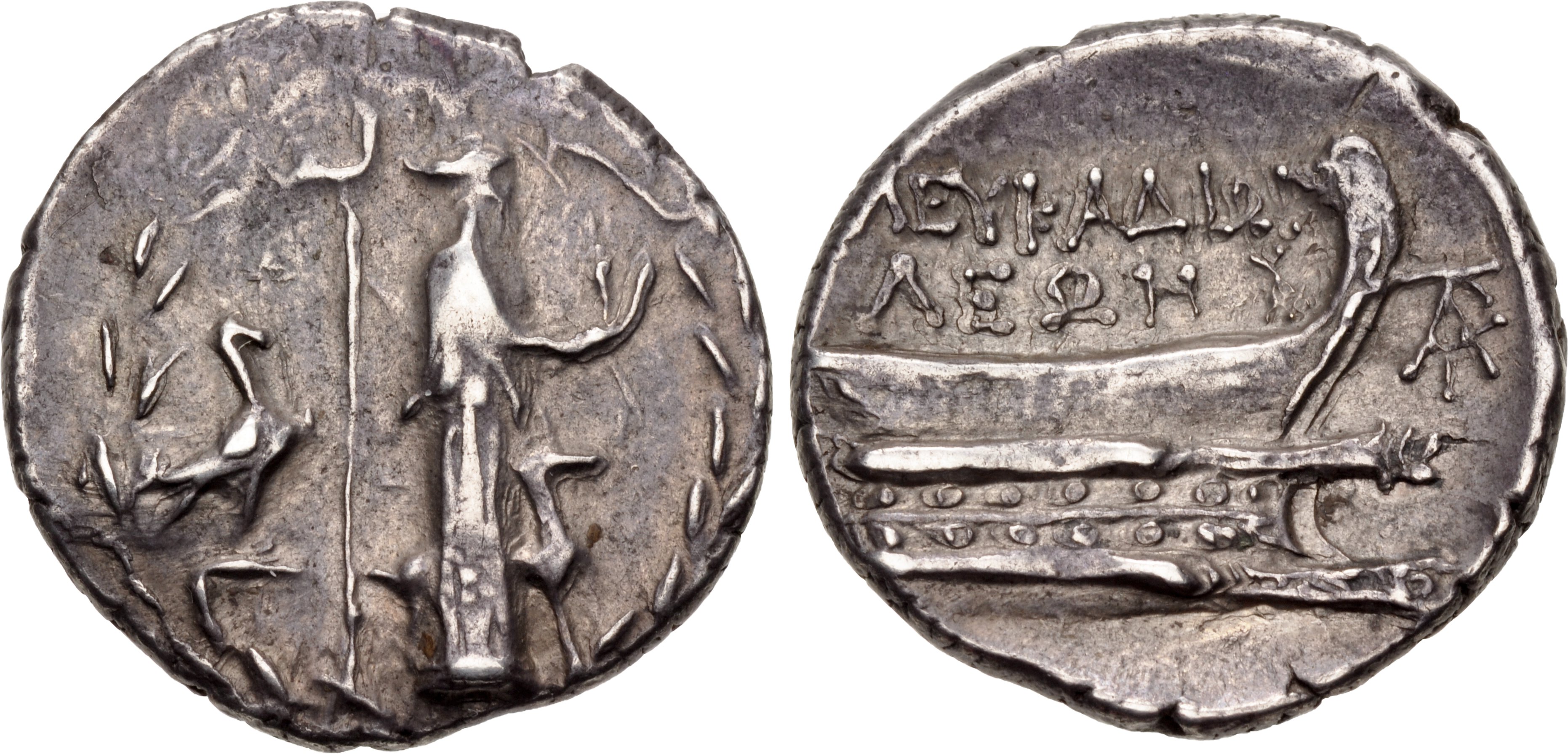Leucas (Roman Republic), silver, didrachms (87 BCE)
From SILVER
87 BCE - 84 BCE Silver 6,095 kg
Description
| ObverseInscription or printing placed on the obverse.: | Statue of Aphrodite Aineias standing right, holding aphlaston, in background, stag standing right, to left, eagle standing right and long scepter surmounted by dove standing right, all within laurel wreath |
| ReverseInscription or printing placed on the reverse.: | ΛEYKAΔIΩN / ΛEΩN (Greek).Prow right, decorated with laurel wreath, [Λ]EYKAΔIΩN/ΛEΩN and monogram in two lines above, monogram to right |
Mint and issuing power
| MintIdentifies the place of manufacture or issue of a numismatic object.: | Leucas | Ancient regionAncient region.: | Acarnania | Modern countryModern country: Greece | AuthorityIdentifies the issuing power. The authority can be "pretended" when the name or the portrait of X is on the coin but he/she was not the issuing power. It can also be "uncertain" when there is no mention of X on the coin but he/she was the issuing power according to the historical sources: | Roman Republic |
Chronology
| FromIdentifies the initial date in a range assigned in a numismatic context. | 87 BCE | toIdentifies the final date in a range assigned in a numismatic context.. | 84 BCE | PeriodTime period of the numismatic object.: Hellenistic 323-30 BC |
Physical description
| MetalThe physical material (usually metal) from which an object is made.: | Silver |
Median weightMedian of the weights of numismatic objects (in grams). in grams | 8.15 | DenominationTerm indicating the value of a numismatic object. Examples: tetradrachm, chalkous, denarius.: | didrachm |
StandardStandard.: | Attic |
Image

S148 Leukas didrachms.jpg [1]
References
| Die study referencePublication of the study: | Callataÿ 2015a1Callataÿ 2015a | ||
| Coin series referenceReference to coin series study: | Sear I2Sear I, n° 2283, HGC 43HGC 4, n° 857 | ||
| Coin series web referenceCoin series web references: | |||
Obverse dies distribution
| FrequencyFrequency of specimen in distribution. ᵖ | Number of obversesNumber of obverse dies. ᵖ (o) | % (o) | Number of coinsNumber of coins. (n) | % (n) | Die nameName(s) of the die(s). |
| 1 | 10 | 28.57 | 10 | 4.5 | 5, 6, 7, 8, 13, 14, 19, 21, 29, 35 |
| 2 | 5 | 14.29 | 10 | 4.5 | 22, 26, 30, 33, 34 |
| 3 | 2 | 5.71 | 6 | 2.7 | 12, 15 |
| 4 | 2 | 5.71 | 8 | 3.6 | 11, 32 |
| 5 | 2 | 5.71 | 10 | 4.5 | 1, 2 |
| 6 | 1 | 2.86 | 6 | 2.7 | 3 |
| 7 | 2 | 5.71 | 14 | 6.31 | 16, 27 |
| 8 | 1 | 2.86 | 8 | 3.6 | 23 |
| 9 | 1 | 2.86 | 9 | 4.05 | 18 |
| 10 | 2 | 5.71 | 20 | 9.01 | 10, 28 |
| 13 | 1 | 2.86 | 13 | 5.86 | 25 |
| 14 | 2 | 5.71 | 28 | 12.61 | 4, 17 |
| 16 | 1 | 2.86 | 16 | 7.21 | 9 |
| 18 | 1 | 2.86 | 18 | 8.11 | 31 |
| 21 | 1 | 2.86 | 21 | 9.46 | 24 |
| 25 | 1 | 2.86 | 25 | 11.26 | 20 |
| Total | 35 of 35 | 100 | 222 of 222 | 99.98 |
Reverse dies distribution
no distribution is available
Quantification
| Number of obversesNumber of obverse dies. ᵖ (o) | 35 | Number of singletons (o1)The number of singleton coins. ᵖ | 11 |
| Number of reverse diesNumber of reverse dies. (r) | 86 | Number of coinsNumber of coins. (n) | 222 |
| Coins per obverse dieNumber of coins per obverse die. (n/o) | 6.34 | Coins per reverse dieNumber of coins per reverse die. (n/r) | 2.58 |
| Reverse per obverse ratioRatio of obverse dies divided by reverse dies. (r/o) | 2.46 | Percentage of singletons (o1)number of coins (n) divided by the number of singletons (o1) ᵖ | 31.43 % |
| Original number of dies (O) (Carter 1983 formula)The estimation of the number of coins according to Carter 1983 ᵖ | 37.39 | Coins struck if 20,000 as average productivity per dieCoins made if the average productivity for obverses (according to Carter) is 20,000. ᵖ | 747,800 |
| Original number of dies (O) (Esty 2011 formula)The estimation of the number of coins according to the singleton formula in Esty 2011 ᵖ (O) | 41.55 | Survival rate if 20,000 as average productivity per dieSurvival rate if average productivity is 20,000. ᵖ | 0.00030 |
| Coverage (o = % of O) (Esty 1984 formula)Esty 1984 - coverage (% of O) ᵖ (o = % of O) | 95.05% | Die productivity if survival rate 1/2,000Average productivity if survival rate is 1/2,000. ᵖ | 11,874.83 |
| Weight of silver (in kg) if 20,000 coins per die (O = Carter formula)Carter 1983 * Median weight * 20000 (*10 if gold or electrum) ᵖ | 6,095 kg <br /> 6,095 kg | Die productivity if survival rate 1/5,000Average productivity if survival rate is 1/5,000. ᵖ | 29,687.08 |
Remarks